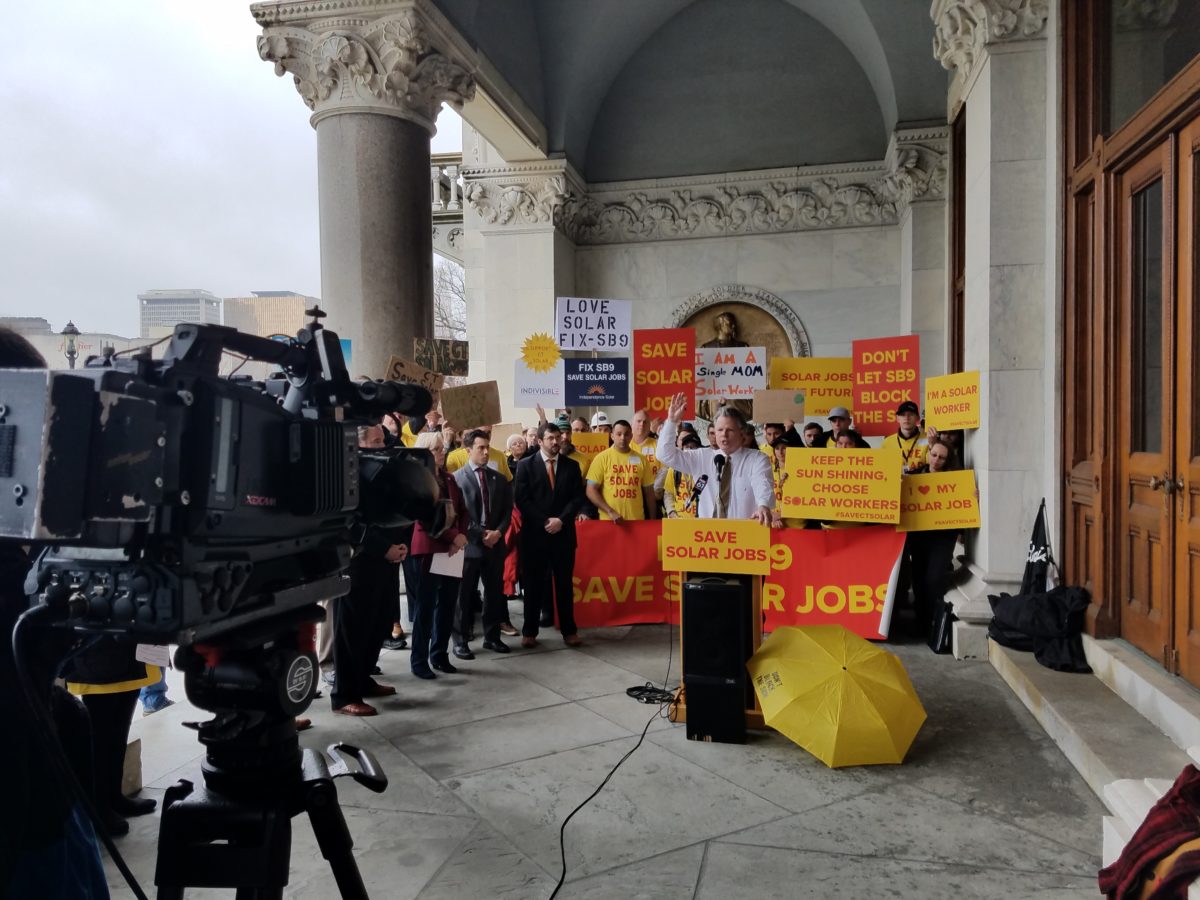We at pv magazine USA strive to bring you the most important and relevant information regarding developments in the U.S. solar industry and markets. These markets live or die under state-level policy, and as such we have been following developments in state legislatures and regulatory bodies across the nation.
In the past we haven’t always been able to get to everything. So in order to provide a full and up-to-date account of developments in each state, we are pleased to bring you the first of our weekly solar power policy roundups. In these roundups we will focus on legislative and regulatory developments large and small in all 51 state-level markets, as well as those at the federal level.
Protests against Connecticut’s plan to gut net metering
Today an estimated 80 or more workers and supporters from at least 11 solar companies attended a rally against legislation that would replace net metering with a system wherein excess electricity generation is credited at a rate based on prices from auctions. Such a change would significantly damage the economics of customer-sited solar.
Senate Bill 9 would simultaneously increase Connecticut’s renewable portfolio standard (RPS) to 40% by 2030. The bill came from the office of Governor Daniel Malloy (D), and is supported by Democratic Party leadership in the state’s General Assembly. The bill was reported out of committee on April 12 and a vote in the full Senate is expected in the next few weeks.
If this bill passes, Connecticut will join Maine and Michigan among the states which have dismantled net metering since the beginning of 2018. It may also set an RPS target which cannot be achieved by in-state generation, as it is difficult to site large-scale wind and solar in densely populated Southern New England.
The protest can be viewed via Facebook Live.
Hawaii establishes performance-based ratemaking
Yesterday Hawaiian Governor David Ige (D) signed a bill to establish “performance-based ratemaking”, under which Hawaii’s utilities will make money not only from returns on their investments, but also for meeting pre-defined performance metrics including renewable energy goals.
Solar advocates including the Hawaii Solar Energy Association (HSEA) applauded SB2939. “Performance based ratemaking is where the rubber meets the road for bleeding edge energy policy,” says HSEA Executive Director Will Giese. “If the 2045 Renewable Portfolio Standard was the vehicle to a clean energy future, then PBR is the engine that will get us there.”
The bill had previously passed the House and Senate unanimously, and Hawaii will be the first state in the nation to have such a change enshrined in statute. Hawaiian regulators must establish performance metrics, incentives and penalty mechanisms under the bill by January 1, 2020.
California Senate committee to hear off-site solar bill
Today the California Senate Energy, Utilities and Communications Committee will hear a bill that would order state regulators to create a new tariff for off-site renewable energy. California State Senator Scott Wiener (D), the bill’s sponsor, notes that while many businesses, public agencies, schools and nonprofits in the state are interested in going solar, they also have little available space to do so. He argues that the states’s warehouses, parking lots, brownfield, landfills and other under-utilized parcels create an opportunity to do so.
Under SB 1399, the California Public Utilities Commission to develop a final tariff that allows other entities to utilize electricity from solar on an estimated 35,000 acres of previously developed parcels no later than January 1, 2021.
The bill has gained the support of a wide range of organizations, including the California Solar & Storage Association, Vote Solar, Clean Coalition, Advanced Energy Economy and Solar Energy Industries Association, as well as many groups outside the solar industry.
Colorado Senate approves energy storage bill
On its third reading, the Colorado State Senate has approved a bill that directs state regulators to come up with mechanisms for the procurement of energy storage by the state’s utilities. This including allowing systems up to 15 MW in capacity to be paid for directly by utility customers, a practice known as “rate-basing”.
The mechanisms must be based on an assessment of costs and benefits. House Bill 18-1270 will now go back to the Colorado House for final approval, as amendments have been added since the bill was initially approved by the chamber. If approved by the House it will go before Governor John Hickenlooper (D).
This content is protected by copyright and may not be reused. If you want to cooperate with us and would like to reuse some of our content, please contact: editors@pv-magazine.com.









this is great! Not to add to your workload, BUT it would be awesome if you could provide an ‘at a glance’ roundup of policy for all 50 states… Ton of work yes, but it would be interesting to know where Maine’s currently insane policy of monitoring gross output fits into the nationwide assault on DG.
Thanks Fred.
This is meant to only be an update of the important developments in the last week. For 50-state roundups, I recommend North Carolina Clean Energy Technology Center’s 50 States of Solar report. Incidentally, we covered the Q1 edition earlier this week, and in the article I mention that Maine’s cuts to compensation are arbitrary, unsupported by evidence, and a transparent attempt to kill distributed solar.
https://pv-magazine-usa.com/2018/04/25/utilities-weaken-distributed-solar-power-with-policy-wins/
So yes, what LePage’s regulators are doing is the worst extreme not only in terms of anti-solar policy but also lack of professionalism/good governance. The good news is that they should be easy to overturn when LePage is term-limited out and Maine has a chance to return to a functional democracy.